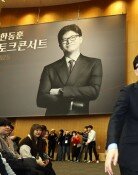[Opinion] Koreas Living Museum
[Opinion] Koreas Living Museum
Posted October. 31, 2005 03:01,
The National Museum of Korea has been flooded with people, after its recent opening. It doesnt seem to be the short-lived popularity that a museum usually enjoys right after it opens. The museum, as Asias largest and one of the worlds sixth largest, has magnificence and a pleasant outdoor park. It is expected to energize the Gangbuk area, along with the renovated Cheonggye Stream.
But there is still room for improvement.
The passage leading to the museum from the subway is so narrow that it is crowded all the time. Obviously, no precautionary measure have been taken, despite the fact that the subway station that was once used by 5,000 people a day is now crowded with tens of thousands of people.
Narrow roads in front of the museum cannot handle the heavier traffic volume the museum brings. The areas transportation infrastructure and its preparedness to handle the crush of visitors pale in comparison to the grandeur and beauty of the museum.
The new museum is filled with new concepts. By housing an 800-seat special theater within the museum, it makes an attempt to combine the museum with a theatre. Traditional museums are characteristically solemn places that simply exhibit historical relics by era. This museum doesnt do that.
The Smithsonian Institution in the U.S. successfully attracts public interest by displaying exhibits in various small museums such as its natural history and aerospace museums. Tokyo National Museum offers its museum-goers both a resting place and a cultural retreat by its proximity to the National Western Art Museum and a zoo in Ueno Park.
The National Museum of Korea seems to have intended to harmonize the seriousness of the museum and the liveliness of the theatre in an effort to breathe new life into the museum concept. But some are voicing concerns, saying that the theatre undermines the quiet atmosphere required for a museum.
But a museum that is visited by nobody is a dead one. The museum should not stay locked in one form only. Indeed, it has been evolving to embrace and entertain more and more people. Guy Sorman, a renowned French scholar who visited Korea to take a look at Yongsan national museum of Korea, said that it should be maintained as a living museum. Of course, the details of its operation will be up to the concerned authorities. But people who visit the museum will have the final say on whether the new experiment of the museum is a success or not.
Hong Chan-sik, Editorial Writer, chansik@donga.com







